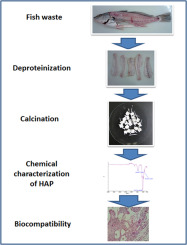Journal of the Mechanical Behavior of Biomedical Materials ( IF 3.3 ) Pub Date : 2018-01-31 , DOI: 10.1016/j.jmbbm.2018.01.035 Hirochi Yamamura , Victor Hugo Pereira da Silva , Pedro Luiz Menin Ruiz , Valter Ussui , Dolores Ribeiro Ricci Lazar , Ana Claudia Muniz Renno , Daniel Araki Ribeiro

|
The aim of this study was to synthesize hydroxyapatite (HAP) powder from fish waste. The powder was characterized through X-ray diffraction, Fourier transform infrared spectroscopy, ion exchange chromatography, scanning electron microscopy and plasma emission spectrometry. The cyto- and genotoxicity was carried out to demonstrate biocompatibility in vivo by means of rat subcutaneous tissue test. The results showed that the visible crystalline nature of typical apatite crystal structure when they were calcined at 800 °C. Infrared spectroscopy analysis showed similar composition to HAP standard with the presence of carbonate ion demonstrated by wave number values of 871 cm−1 and 1420 cm−1 for calcinations at 800 °C. The scanning electronmicrographies depicted the crystal morphology and porous nature with average pore size of ~10 µm. Plasma emission spectrometry and ion exchange chromatography confirmed the presence of Ca and P in the samples. The mean of calcium content was 36.8; Mg was 0.8, Na was 0.7 and K was 0.5. Rat subcutaneous tissue test revealed that HAP presented biocompatibility. Furthermore, the lack of cyto- and genotoxicity in blood, liver, kidney and lung were noticed after 30 days of HAP implantation. Taken together, our results demonstrated that HAP from fish waste exhibits a great potential for using as biomaterial since is represents a simple, effective, low-cost process and satisfactory degree of biocompatibility.
中文翻译:

鱼粪中羟基磷灰石的理化特性和生物相容性
这项研究的目的是从鱼粪中合成羟基磷灰石(HAP)粉末。通过X射线衍射,傅立叶变换红外光谱,离子交换色谱,扫描电子显微镜和等离子体发射光谱对粉末进行表征。通过大鼠皮下组织测试进行了细胞毒性和遗传毒性以证明体内生物相容性。结果表明,典型的磷灰石晶体结构在800°C下煅烧时具有可见的晶体性质。红外光谱分析显示出与HAP标准品相似的成分,并存在碳酸盐离子,波数值分别为871 cm -1和1420 cm -1在800°C下煅烧。扫描电子显微照片描绘了晶体形态和多孔性质,平均孔径为〜10 µm。等离子体发射光谱法和离子交换色谱法证实了样品中Ca和P的存在。钙含量平均值为36.8;Mg为0.8,Na为0.7,K为0.5。大鼠皮下组织测试表明,HAP具有生物相容性。此外,在HAP植入30天后,发现血液,肝,肾和肺中缺乏细胞和基因毒性。综上所述,我们的结果表明,来自鱼粪中的HAP代表着一种简单,有效,低成本的过程以及令人满意的生物相容性,因此具有用作生物材料的巨大潜力。











































 京公网安备 11010802027423号
京公网安备 11010802027423号